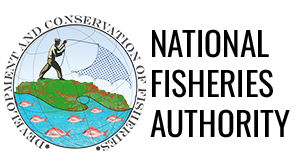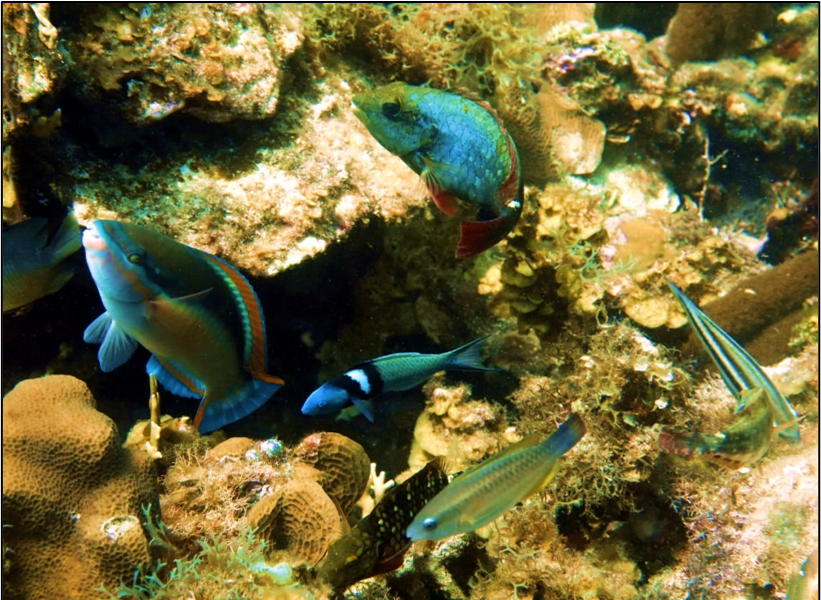Author: National Fisheries Authority, Capture Fisheries Division
Jamaica’s fishing industry plays an important role in the nation’s economy and provides livelihoods for many of its people. More than 30,000 thousand registered fishers carry out their trade in the local industry, fishing primarily for reef fishery resources. At the centre of the reef fishery, Parrotfish play a major role. This family of fishes not only contributes to a large part of the “catch” for Jamaica’s predominantly small-scale fishers, but also serve as one of the key herbivores in the island’s coral reef ecosystems. As grazers on coral reefs, Parrotfish species aid in maintaining the health and balance of these marine ecosystems.
However, Jamaica’s coral reefs, like many around the world, face multiple threats. Overfishing, climate change, coastal development leading to sedimentation, pollution, diseases, and natural disasters all pose significant challenges to these delicate ecosystems. The health of these reefs is intrinsically linked to the sustainability of Jamaica’s fisheries, creating a complex interplay between conservation and economic needs.
FACTS about the ecological role and diversity of Parrotfish and other grazers:
One of the special qualities of parrotfish is their ability to feed on algae that grow on coral reefs. This helps living corals obtain more sunlight and use photosynthesis to make food by controlling the growth of algae. Coral reefs depend on this symbiotic interaction to survive and thrive. Furthermore, parrotfish aid in the development of sandy beaches by breaking down coral skeletons into fine sand during their digestive process (bioerosion).

Studies have shown however, that a diverse assemblage of species is important for healthy reefs. For example, when both Parrotfishes and Surgeonfishes are present, benthic algal assemblages are mostly turf algae rather than macroalgae-dominated, which translates into associated benefits to corals. The studies found that Parrotfishes and Surgeonfishes feed in separate reef areas, with some Parrotfishes spending most of their time feeding in reef habitats that comprise <20% of the total reef area. Moreover, Surgeonfishes have a diverse herbivore diet as they help to control algal turfs as well as calcified algae. However, these fish avoid feeding on the mature stages of many species of macroalgae, and are unable to prevent macroalgae from spreading once established. In contrast, Parrotfish species frequently feed on mature macroalgae, but are less effective at suppressing algal turfs that may inhibit coral recruitment. Surprisingly, some species previously considered invertebrate feeders, such as Chubs (Kyphosus spp.), Batfish (Platax pinnatus), and Triggerfish (Balistes spp.), have been found to consume macroalgae, highlighting the need for a multitude of taxa in the restoration of fish herbivory.
Along with these herbivores, five Sea Urchin genera (Diadema, Echinometra, Tripneustes, Eucidaris, and Lytechinus) commonly found on Caribbean coral reefs also consume macroalgae. One in particular, is the Long-spined Sea Urchin Diadema antillarum, which is considered one of the most important herbivorous sea urchins due to its historical high densities and generalist macroalgal-based diet. The loss of the Long-spined Sea Urchinduring the 1980s led to increased macroalgae on many Caribbean reefs, especially those with few herbivorous fishes. This suggests that the urchin species is especially effective at controlling algae and facilitating coral growth.
MYTH: Banning the consumption of all parrotfish species would be sufficient to save Jamaica’s coral reefs.
Oversimplification of the issue fails to consider the complex socio-economic factors at play and the multiple threats facing coral reefs. While reducing the fishing pressure on parrotfish is fundamental for their conservation, it is essential to recognize that fishing is an important source of livelihood and food security within many Jamaican communities.

Furthermore, it is evident that all herbivores do not carry out the same function on reefs. Thus, understanding how different herbivorous species affect reef ecosystems is essential for developing effective fishery management strategies. An outright ban on Parrotfish might have unforeseen repercussions and disproportionately affect the people who depend on this resource. Another key fact to note is that fish traps are one of the most widely used and effective method to catch reef fish in Jamaica. These traps are not species-specific, and thus do not target Parrotfish in particular. According to the Reef Fish Survey Report put out by the National Fisheries Authority in 2023, based on sampling across Jamaica, the catch composition showed that Parrotfishes were the most dominant of 16 fish families normally caught by fish traps. This accounted for 27% of total landings. The survey also showed that herbivores accounted for over 34% of fish landed by fish traps. To place a ban on the fishing of Parrotfishes, or any herbivorous fish, would be to criminalize the use of fish traps altogether, which could seriously cripple the artisanal fishing industry. Rather, a more all-encompassing and holistic strategy is required to strike a balance between local community food security needs and conservation objectives.
What Can Be Done?
To properly manage reef fisheries and Parrotfish populations, an Ecosystem-based Approach to Fisheries Management (EAFM) method is advised. Rather than concentrating on a particular species or problem in isolation, EAFM considers the intricate relationships that exist between species, habitats, and human activity. This comprehensive method considers all the variables influencing the health of coral reefs and other marine (or fisheries) habitats. Once these requirements are understood, fishing effort should be regulated to maintain fish populations at sizes that not only sustain the fishery yield but also exceeds the minimum level necessary to support the ecosystem’s needs.

Take Home Message
It takes strong institutional ability, scientific know-how, and political resolve to put an EAFM strategy into practice. It also calls for a sustained dedication to collaboration between stakeholders, adaptive management, and monitoring. An EAFM strategy can assist in enhancing resilience in coral reef ecosystems and the human communities that depend on them by tackling a variety of stresses and incorporating a wide range of stakeholders.
Finally, while the conservation of Parrotfish is necessary for the health of Jamaica’s coral reefs, it is essential to approach the issue holistically and base management decisions on scientific evidence. Oversimplifying the problem and proposing “single species” bans without considering the socio-economic context can lead to unintended consequences and undermine conservation efforts. By adopting an ecosystems approach to fisheries management that balances ecological, social, and economic needs, Jamaica can work towards the sustainable management of its reef fisheries and parrotfish, and by extension the long-term health of our coastal ecosystems.

